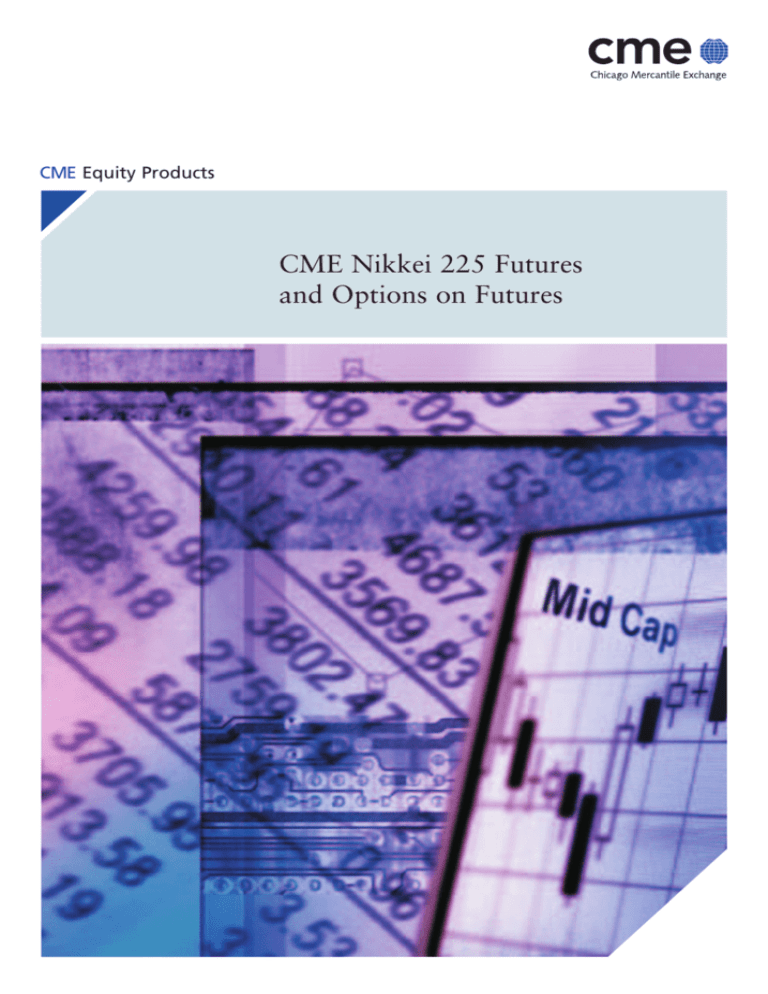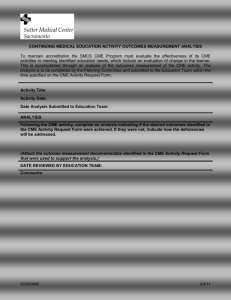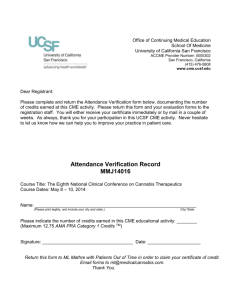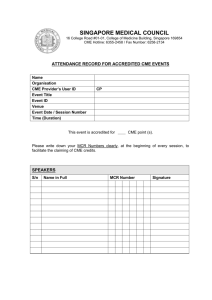
CME Equity Products
CME Nikkei 225 Futures
and Options on Futures
Global Leadership in the Financial
Marketplace
CME is the largest and most diverse financial futures and options
exchange in the world – handling nearly 800 million futures contracts
worth more than $460 trillion in a single year. Founded in 1898, we
serve the risk-management needs of customers around the globe by
offering the widest range of benchmark financial products available
on any exchange, traded via the CME Globex electronic trading
platform and on our trading floors.
Our innovative, diverse products encompass major market segments –
including interest rates, equities, foreign exchange, commodities and
alternative investment products - and improve the way these markets
work for customers everywhere.
CME Equity Products
CME is the dominant marketplace for equity derivatives. More than
90 percent of all U.S. stock index futures and options trade at our
exchange, presenting one of the world's most liquid trading
environments for equity products. CME offers the widest array of
equity futures and options on futures products, which include the
S&P 500 and S&P MidCap 400 Indexes, the NASDAQ-100 Index, the
Russell 1000 and Russell 2000 Indexes, and the Nikkei 225 Index.
Table of Contents
PAGE
ABOUT CME NIKKEI 225 FUTURES AND OPTIONS
2
WHY TRADE CME NIKKEI 225 FUTURES AND OPTIONS?
4
ABOUT THE UNDERLYING INDEX
5
CONTRACT SPECIFICATIONS: CME NIKKEI 225 FUTURES
7
CONTRACT SPECIFICATIONS: CME NIKKEI 225 OPTIONS
8
EXAMPLE 1: Hedging with Dollar-Denominated CME Nikkei 225 futures
9
EXAMPLE 2: Equitization with Yen-Denominated CME Nikkei 225 futures
10
EXAMPLE 3: Spread Trading with U.S. and Japanese Stock Index futures
11
OTHER POSSIBLE STRATEGIES
12
CME NIKKEI 225 FUTURES VS. JAPANESE ETFS
13
GETTING STARTED IN CME NIKKEI 225 FUTURES AND OPTIONS
14
CME EQUITY PRODUCT LISTING
15
CME Nikkei 225 Futures and Options on Futures
1
About CME Nikkei 225 Futures and Options
In the 1980s, the Japanese marketplace rose to
prominence, capturing the attention – and capital – of
investors around the world. Today, Japan ranks as the
second-largest marketplace in the world (in terms of
capitalization), and continues to offer compelling
opportunities for investors with a global perspective.
To help investors harness these opportunities, CME offers
futures and options on futures on the Nikkei 225 Stock
Average, the most widely followed and frequently quoted
Japanese stock index. With one transaction, CME Nikkei
225 futures and options give investors access to the 225
top-rated, blue-chip Japanese companies tracked by the
underlying index – including such well-known issues as
Honda, Canon and Sony.
Dollar-denominated CME Nikkei 225 futures and options
» Trade on the CME Globex electronic trading platform
side-by-side with open outcry.
» Trade electronically before and after open-outcry,
providing an extended trading day for customers
around the world.
» Offer convenience for investors with portfolios
comprised of dollar-based investments – removing
the need for foreign exchange conversions.
Yen-denominated CME Nikkei 225 futures
» Trade only on the CME Globex electronic trading
platform, virtually around the clock.
» Offer the flexibility of clearing at either CME or the
Though originally traded only via open outcry and in
dollar-denominated contracts, the contracts have evolved
to match changing customer needs. Today, CME
customers have a choice of currencies and trading
venues for this product:
2
Singapore Exchange (SGX) as part of the Mutual Offset
System (MOS). See page 3 for more on this feature.
» Offer convenience for investors with portfolios
comprised of yen-based investments – removing the
need for foreign exchange conversions.
cme.com
About CME Nikkei 225 Futures and Options
CME Nikkei 225 futures products have experienced
strong growth in volume and liquidity since their launch.
In 2004, volume for CME Nikkei 225 futures contracts
combined exceeded 1.4 million contracts. Through
November 2005, year-to-date volume for CME Nikkei
225 futures contracts had exceeded 2 million contracts.
Figure 1 shows annual volume of CME Nikkei 225 futures.
Figure 1: Annual Volume of CME Nikkei 225 Futures
(dollar- and yen-denominated)
2000
455,298 USD-based
2001
476,300 USD-based
2002
571,200 USD-based
2003
765,463 USD-based
2004†
1,239,010 USD-based
260,120 Yen-based
2005 YTD November*
1,572,050 USD-based
777,324 Yen-based
†Yen-denominated futures were first launched in 2004.
*Through November 2005
Source: CME Equity Products
The Mutual Offset System (MOS)
To provide customers in different time zones greater
trading access and convenience, in 1984 CME entered
into a special trading arrangement with the Singapore
Exchange (SGX). This Mutual Offset System (MOS) allows
traders to take positions on one exchange and offset
them on the other. It also enables the two exchanges
to provide around-the-clock access – and essentially, a
single marketplace – for the contracts eligible for mutual
offset: yen-based CME Nikkei 225, CME Eurodollar,
CME Euroyen and CME Japanese Government Bond
(JGB) futures.
How the MOS Works
When yen-based CME Nikkei 225 futures trading is
closed, a CME trader can use the MOS to execute an
order through the Singapore Exchange as an extension
of the CME electronic trading venue. Similarly, if SGX is
closed, an SGX trader can use the MOS to execute an
order through CME as an extension of the SGX trading
venue. Traders must designate these as mutual offset
transactions at the time the trades are executed. CME
determines daily settlement prices for CME customer
trades mutually offset at SGX. Similarly, SGX determines
daily settlement prices for its customers' trades mutually
offset at CME. Customers who use the MOS in yen-based
CME Nikkei 225 futures:
» May carry a position at SGX or CME.
» Pay clearing fees only at the exchange that executes
the order.
» Post performance bond margins only with their
“home” exchange.
Advantages of the MOS agreement between CME and SGX:
» Immediate, uninterrupted access to CME Nikkei 225
futures contracts in different time zones.
» Combined liquidity and depth of CME and SGX
markets as well as the credit risk safety of the CME
and SGX clearing houses.
» Complete fungibility of contracts.
» An easy, flexible and cost-efficient linkage process.
CME Nikkei 225 Futures and Options on Futures
3
Why Trade CME Nikkei 225 Futures and Options?
CME Nikkei 225 futures and options are powerful,
versatile financial tools that offer the following:
Sector Exposure
Customers can participate in Japanese equity markets with
one trading decision, without taking up valuable time and
resources to painstakingly select individual issues.
Risk Management
Like other CME index futures, these products tend to
closely track the underlying cash index, providing risk
management and investing opportunities for financial
institutions, investment managers, corporations, financial
professionals and individual investors. Participants can
minimize the systematic (market) risk of a portfolio with
Japanese equities and protect the value of the portfolio
during bear markets without incurring high transaction
costs, taxes, and custodial fees.
Trading Strategies
Traders can use these contracts to quickly and efficiently
engage in global asset allocation strategies, including
outright long or short positions, spreading against other
indexes, hedging strategies, arbitrage, and cash
equitization strategies.
4
Cost Efficiency
Only a small upfront performance bond deposit is
required, offering low transaction costs relative to buying
each stock in the index.
Electronic Access/Ease of Trading
These products trade on the CME Globex electronic
trading platform virtually around the clock. Customers
can access the platform through 740 direct connections
in 27 countries as well as through eight telecommunications
hubs – in London, Amsterdam, Dublin, Frankfurt, Gibraltar,
Milan, Paris and Singapore – that provide reduced
connectivity costs, increased accessibility, and fast,
efficient trading.
Market Integrity/Fully Integrated Clearing
CME Clearing matches and settles all trades and
guarantees the creditworthiness of every transaction in
our markets. Our integrated clearing function ensures
the safety and soundness of our markets and helps
differentiate us from our competitors. With CME Clearing
serving as the counterparty to every trade, credit risk is
virtually eliminated.
cme.com
About the Underlying Index
The Nikkei 225 Stock Average Index is one of the oldest
Japanese market barometers, first calculated in May 1949
by Nihon Keizai Shimbun, Inc. (NKS), a leading Japanese
financial information services firm.
Figure 2: Top 20 Stocks In The Nikkei 225 Index*
It is structured to reflect the Japanese stock market using
the 225 top-rated, blue-chip Japanese companies listed
in the First Section of the Tokyo Stock Exchange (TSE).
Unlike the S&P and Russell Indexes, which are marketcapitalization weighted, the Nikkei 225 Index is priceweighted. That means higher-priced stocks have a greater
percentage impact on the Index than lower-priced stocks.
The number of shares outstanding has no influence on
the weightings. Figure 2 shows the top issues represented
in the Nikkei 225 Index. Figure 3 (see page 6) shows
month-end prices.
Today, the Japanese market as measured by the Nikkei
225 Stock Average Index ranks among the largest of the
developed markets in terms of market capitalization.
Figure 4 shows a comparison of key country benchmark
indexes by market capitalization (see page 6).
Weighting
Company
in Index
1
Fanuc Ltd
2.72%
2
TDK Corp
2.54%
3
Advantest Corp
2.53%
4
Fast Retailing
2.36%
5
Kyocera Corp
2.24%
6
Softbank Corp
2.12%
7
KDDI
2.07%
8
Takeda Pharmaceutical Ltd
1.94%
9
Honda Motor Co
1.89%
10.
Canon Inc
1.82%
11.
Secom Co Ltd
1.78%
12.
Tokyo Electron
1.78%
13.
Shin-Etsu Chemical
1.67%
14.
Credit Saison Co Ltd
1.60%
15.
Toyota Motor Corp
1.58%
16.
CSK Holdings Corp
1.33%
17.
Eisai Co Ltd
1.33%
18.
NTT Data Corp
1.26%
19.
Astellas Pharma Inc
1.25%
20.
Seven & I Holdings Co Ltd
1.19%
*Source: Bloomberg. Data as of November 4, 2005.
CME Nikkei 225 Futures and Options on Futures
5
About the Underlying Index
Figure 3: Nikkei 225 Stock Average Index Month-End Prices Through November 2005
45,000 Nikkei 225 Month-End Prices
40,000
35,000
30,000
25,000
20,000
15,000
10,000
5,000
Jan-05
Nov-05
Jan-03
Jan-04
Jan-02
Jan-01
Jan-00
Jan-99
Jan-98
Jan-97
Jan-96
Jan-94
Jan-95
Jan-93
Jan-92
Jan-91
Jan-89
Jan-90
Jan-88
Jan-86
Jan-87
Jan-85
Jan-84
Jan-83
Jan-82
Jan-81
Jan-80
0
Figure 4: Market Capitalization of Stock
Indexes by Country
Total Market
Country/City
Index
Cap (USD)*
USA
S&P 500
11.3
UK
FTSE 100
2.7
Japan
Nikkei 225
2.6
France
CAC 40
1.2
Canada
S&P/TSX
1.1
Germany
DAX
0.8
Hong Kong
Hang Seng
0.6
Mexico
IPC
0.2
Market cap in trillions of U.S. dollars – data as of November 4, 2005.
Source: Bloomberg.
6
cme.com
Contract Specifications: CME Nikkei 225 Futures
Please note that there are some important differences in contract specifications among the products in
the CME Nikkei 225 futures complex.
Contract Specifications
Dollar-Denominated
Yen-Denominated
Open Outcry: NK
Open Outcry: Not applicable
CME Globex Platform: NKD
CME Globex Platform: NIY
$ 5.00 x CME Nikkei 225 futures price
¥ 500 x CME Nikkei 225 futures price
Fluctuation (Tick)
Five index points = $25 dollars
Five index points = ¥ 2,500
Contract Months
Mar, Jun, Sep, Dec
Mar, Jun, Sep, Dec
Open Outcry Hours
08:00 - 15:15
Not applicable
CME Globex Trading Hours
03:00 - 15:15
Reopens 15:30 - 16:30
Closes 16:30 - 17:00
Reopens 17:00 - 18:00
06:00 - 15:15
Reopens 15:30 - 16:30
Closes 16:30 - 17:00
Reopens 17:00 - 18:00
02:00 - 15:15
Reopens 15:30 - 16:30
Closes 16:30
(Does not reopen at 17:00)
06:00 - 15:15
Reopens 15:30 - 16:30
Closes 16:30
(Does not reopen at 17:00)
Ticker Symbols
Contract Size
Minimum Price
(Daylight Saving Time)
CME Globex Trading Hours
(Central Standard Time)
Daily Settlement Time
All trades executed after 15:15 settlement time will have the next day's trade date
Price Limits*
Lead Month Settlement
Daily Limit (Index Points)
0 – 20,000
20,005 – 30,000
30,005 and up
1,000
Position Limits
5,000 contracts
5,000 contracts
Last Trading Day
Business day preceding the second Friday of the contract month
immediately preceding the day of determination of the final settlement price
Final Settlement Price
Based upon a Special Opening Quote of the Nikkei 225 Stock Average
referencing the opening values of constituent stocks
1,500
2,000
*Applicable to both yen- and dollar-denominated contracts.
CME Nikkei 225 Futures and Options on Futures
7
Contract Specifications: CME Nikkei 225 Options on Futures
The contract specifications for options on dollar-denominated CME Nikkei 225 futures are as follows:
Options
Ticker Symbols
Calls: KN
Puts: JN
Underlying Contract
One dollar-denominated CME Nikkei 225 futures contract
Open Outcry Hours
(Central Time)
08:00 - 15:15
Minimum Price
Fluctuation (Tick)
Five index points ($25.00)
Contract Months
All 12 calendar months
Last Day of Trading
Quarterly options: Same date as underlying futures
Other eight months: Third Friday of the contract month
Position Limits
5,000 futures-equivalent contracts net on the same side of the market
in all contract months combined
Last Trading Day
Business day preceding the second Friday of the contract month
Final Settlement Date
Based upon a Special Opening Quotation of the Nikkei 225 Stock Average Index
referencing the opening values of constituent stocks
Settlement Procedures
Cash settlement to the Special Opening Quotation of the Nikkei Stock Average Index
Option Exercise
American Style. An option can be exercised until 7:00 p.m. Chicago time on any
business day the option is traded. An option that is in-the-money and has not been
exercised prior to the termination of trading shall, in the absence of contrary instructions,
be delivered to CME Clearing by 7:00 p.m. on the day of determination of the Final
Settlement Price, and be automatically exercised.
8
cme.com
Example 1: Hedging with Dollar-Denominated
CME Nikkei 225 Futures
Situation
A pension fund portfolio manager with $100,000,000 in assets has 5% of his portfolio in
blue chip Japanese equities. Because he believes the Nikkei 225 Stock Average will decline
by 10% or more in the next few months, he decides to hedge the $5,000,000 in
Japanese exposure with CME dollar-denominated Nikkei 225 futures.
Strategy
Initiate a short hedge using dollar-denominated CME Nikkei 225 futures. Each futures
contract has a notional value of $75,000 USD (price of CME Nikkei futures contract,
15,000 x $5 multiplier = $75,000)
Determining the Number
Number of contracts = Value of Japanese equities to hedge
Notional value of futures contracts
= $5,000,000/$75,000
= 67 CME Nikkei 225 futures contracts
of Futures Contracts
Required
Possible Outcomes
If the Nikkei 225 Stock Average drops as the portfolio manager expects, the profits on the
short hedge would help to offset the losses incurred by his Japanese stocks – effectively
protecting him from the downdraft in Japanese shares. However, if the Nikkei 225 Stock
Average advances, the short hedge would show losses that would offset the likely gains in
his portfolio – effectively preventing the portfolio manager from participating in any
upside moves.
Note: Strategy I shows that hedging strategies have to be “managed.” In a rising market the manager would have to reassess his bearish opinion and, if
necessary, lift his hedge to enable the portfolio to take advantage of an advancing market. If the manager was correct and the hedge protected the portfolio
against the downside, he would have to lift the hedge at some point if the market shows signs of turning up.
CME Nikkei 225 Futures and Options on Futures
9
Example 2: Cash Equitization with Yen-Denominated
CME Nikkei 225 Futures
Situation
A Japan-based money manager has ¥ 100 billion indexed to the Nikkei 225 Stock
Average. A recent ¥ 1 billion inflow of investor money must be quickly and efficiently put
to work or the manager risks underperforming his benchmark (i.e., the cash needs to be
“equitized”). Moreover, the manager's research indicates continuing strength of the yen
versus the U.S. dollar.
Strategy
¥ 1,000,000,000 cash equitization strategy
15,250 = Yen-denominated CME Nikkei 225 futures
Prices Available
15,300 = Nikkei 225 Stock Average spot price
15,315 = Nikkei 225 futures fair value estimate
Currency Risk
The Choice
Yen/dollar currency risk, rendered moot by use of yen-denominated futures
To buy a basket of equities indexed to the Nikkei 225 or purchase
yen-denominated CME Nikkei 225 futures contracts
The Decision
Because the futures contract is trading below fair value, the manager decides to equitize
the cash by purchasing yen-denominated CME Nikkei 225 futures.
Determining the Number
Number of contracts
of Futures Contracts
Required
= Amount of investment to be equitized
Contract notional value (multiplier x index futures level)
= ¥ 1,000,000,000
¥ 7,625,000
= 131 CME Nikkei 225 futures contracts
The manager will need to purchase 131 CME Nikkei futures contracts in order to effectively equitize ¥ 1 billion in exposure.
Using futures contracts offers several advantages over his other choices:
» In general, executing a single futures contract is easier than trading 225 individual stocks.
» Futures frequently represent the lower cost alternative in terms of execution costs.
» Trading the product on the CME Globex platform offers the benefits of speed and efficiency.
» The manager gains the flexibility of a product with mutual offset availability in the Asian Time Zone
via the Singapore Exchange.
10
cme.com
Example 3: Spread Trading with U.S. and Japanese Stock Index Futures
Situation
A U.S.-based macro-strategy hedge fund manager is convinced that the bear market in
Japan has ended and that the Nikkei 225 Stock Average is poised to outperform large-cap
stocks in the U.S. Rather than assemble baskets of long and short positions, the manager
decides to employ a spread trade using stock index futures.
Strategy
Go long Japanese equities using CME Nikkei 225 futures (dollar-denominated)
Go short U.S. equities using CME E-mini S&P 500 futures
The advantages of such a spread strategy include the following:
» Using futures precludes the need to assemble large baskets of long and short equities.
» Using futures requires less capital, as the upfront performance bond margin would be lower than the Regulation T
margins required with equities.
» Spreading allows the hedge fund the potential to profit from generally rising or falling global equity markets. The key
factor in such a strategy is that Japanese issues must outperform U.S. large-cap issues by either going up more in a
bull market or falling less in a bear market. However, losses would occur if U.S. large-caps outperformed Japanese equities.
» Using CME dollar-denominated products eliminates currency risk, thus allowing the trader to focus on equity market
performance only.
CME Nikkei 225 Futures and Options on Futures
11
Other Possible Strategies
The preceding three trading examples are only a small sample of the many strategies available to a knowledgeable
investor. In addition to hedging, cash equitization and spreading, institutional investors can use CME Nikkei 225
futures and options on futures for a host of strategies, such as:
» Enhanced Indexing
» Strategic/Tactical Asset Allocation
» Creating Synthetic Money Market Instruments
» Futures/Options Combinations, Spreads, and Other Complex Strategies
» Futures/Options Arbitrage
» Cash Futures Index Arbitrage
» Futures/ETF Arbitrage
You can learn more about these types of trading strategies at the online CME Education Center, at
www.cme.com/edu. There you will find online seminars and strategy papers available for download.
12
cme.com
CME Nikkei 225 Futures vs. a Japanese Equity ETF
Exchange-Traded Funds (ETFs) have become popular with traders over the last decade. ETFs represent a basket of securities
traded on an exchange and are similar to index-based mutual funds but are traded more like stocks. They offer distinct
advantages over mutual funds, in that investors can employ a variety of trading strategies using these instruments.
When comparing CME Nikkei 225 products versus Japanese ETFs, however, the CME Nikkei 225 products offer advantages
that may make it the better vehicle for traders to use, as the comparison below shows.
CME Nikkei 225 Futures Complex
iShares MSCI Japan ETF
Where Traded
CME
AMEX
Average Daily Dollar Volume
$660,000,000/day
$163,000,000/day
Options
Yes
No
Extended Trading/MOS
Yes
No
Lower Capital Requirements
Yes
No
Yen/Dollar Risk
No (with USD-based futures)
Yes
Source: CME
As of November 2005.
CME Nikkei 225 Futures and Options on Futures
13
Getting Started in CME Nikkei 225 Futures and Options
For additional information to help you get started trading CME Nikkei 225 futures and options on futures, please visit our
web site at www.cme.com/equities. You will be able to access a number of brochures and online seminars as well as
marketing and education materials that can answer your questions or help you to begin trading these CME equity futures
and options on futures products. Also, if you would like to talk to a CME representative, please call our Customer Service
Line at 1-800-331-3332 or contact your broker.
CME Publications
» CME Equity Index Futures and Options Informational Guide
CME Web Sites
» www.cme.com/equities
» www.cme.com/nikkei
Singapore Exchange (part of Mutual Offset System)
Singapore Exchange Limited
2 Shenton Way
#19-00 SGX Centre 1
Singapore 068804
Tel: (65) 6236 8888Fax: (65) 6534 1415
www.sgx.com
14
cme.com
CME Equity Product Listing
CME offers a complete range of futures and options products based on a variety of different indexes, including:
» CME NASDAQ-100
» CME S&P 500
» CME E-mini NASDAQ-100
» CME E-mini S&P 500
» CME E-mini NASDAQ Composite
» CME E-mini S&P Asia 50
» CME E-mini NASDAQ Biotechnology
» CME S&P MidCap 400
» CME Russell 2000
» CME E-mini S&P MidCap 400
» CME E-mini Russell 2000
» CME S&P SmallCap 600
» CME E-mini Russell 1000
» CME S&P/Citigroup Growth
» CME E-mini MSCI EAFE
» CME S&P/Citigroup Value
» CME Nikkei 225
» CME SPCTR Futures
» CME Futures on ETFs
» CME Goldman Sachs Commodity Index (GSCI)
» TRAKRS (Total Return Asset Contracts)
For more information on these products, visit www.cme.com.
CME Nikkei 225 Futures and Options on Futures
15
Futures trading is not suitable for all investors, and involves the risk of loss. Futures are a leveraged investment, and
because only a percentage of a contract's value is required to trade, it's possible to lose more than the amount of
money you've deposited for a futures position. Therefore, you should only use funds that you can afford to lose without
affecting your lifestyle. And only a portion of those funds should be devoted to any one trade because you can't expect
to profit on every trade.
All references to options in this brochure refer to options on futures.
The Nikkei® Stock Average is owned by and proprietary to Nihon Keizai Shimbun.
The Globe Logo, CME®, Globex® and E-mini® are trademarks of CME. All other trademarks are the property of their respective owners.
“S&P®” and “S&P 500®” are trademarks of The McGraw-Hill Companies, Inc. and have been licensed by CME for the trading of futures products. These
products are not sponsored, endorsed, sold or promoted by S&P, a division of The McGraw-Hill Companies, Inc., and S&P makes no representation regarding the
advisability of investing in them.
The Russell 1000® Index and Russell 2000® Index are registered trademarks of Frank Russell Company. Frank Russell Company assumes no liability in
connection with the trading of any contract based on the Russell 1000 or Russell 2000 Indexes.
iShares® is a registered trademark of Barclays Global Investors, used under license.
MSCI EAFE® is a trademark of MSCI, used under license.
The information within this brochure has been compiled by CME for general purposes only. CME assumes no responsibility for any errors or omissions.
Additionally, all examples in this brochure are hypothetical situations, used for explanation purposes only, and should not be considered investment advice or the
results of actual market experience.
All matters pertaining to rules and specifications herein are made subject to and are superseded by official CME rules. Current CME rules should be consulted in
all cases concerning contract specifications.
Copyright © 2005 CME. All rights reserved.
16
cme.com
IDEAS THAT CHANGE THE WORLDTM
EQ043/3M/0106






